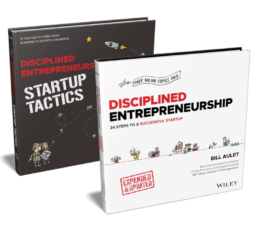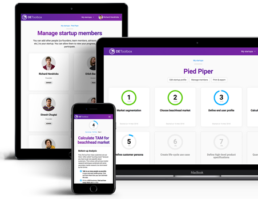Sign up for our newsletter
The Disciplined Entrepreneurship Toolbox
Stay ahead by using the 24 steps together with your team, mentors, and investors.
The dynamics that shape judgment and behaviour have always been in the spotlight of managerial curiosity, since our choices take place within a vast horizon of options, and especially for deliverables with high intrinsic and extrinsic value, like education.
What almost two decades in the field of management consulting and market research taught me, is that overall, there is a tendency for evaluations to concentrate on the improvement of the measurement based on pre-existing conceptualizations and to the logical faculty.
Prof. Bill Aulet in his latest article (Dec 2019) on Disciplined Entrepreneurship (DE) education international impact assessment, has highlighted three undoubtedly impressive and promising data points that represent DE’s impact, namely a) company longevity after the end of the program, b) Return on Educational Investment (ROEI) and c) projected revenues of program participants.
Widening the horizon of DE’s Impact Assessment
When looking at these dimensions of DE’s market impact, the first thing that comes to my mind is that the presence of emotion is felt by its absence. The second thing is that this approach to evaluating educational programs seem to favour those who believe the idea of DE being strictly an educational and managerial tool.
The third thing is that it doesn’t seem to consider the needs, aspirations, motivations and expectations of all four of the already well-defined personas (Exploratory/Curious, Ready-to-Go, Entrepreneurship Amplifiers and Corporate Entrepreneurs).
The premise behind this idea is simply that not all of these learners aim or even care about ROEI or revenue projections. Some might look for inspiration. Others might look for a community, while others might look for plain vanilla education. It is clear to me that these numbers are made for the eyes of the academic institution and not for those of the learners.
However, when analysts reduce variance in impact assessments, they do indeed serve the logical faculty by eliminating or adjusting outliers, substantiating statistically that as many learners as possible occupy the middle of the normal distribution curve in service of the greater good, reducing in most cases unnecessary complexity and helping to standardize operations, a precondition for achieving scale.
While reducing variability may result in practical and actionable insights, trim costs, and save time it will also result in consistent myopic observations that could miss the mutations, user stories, experiences and new use cases at the edges of the DE learner journeys. And this is where innovation happens.

For that reason, we should widen the horizon of observation, retain and monitor the outliers, and embrace variability by coupling DE’s ROI with learners’ experiences to better understand DEs broader impact.
The inevitable mutation of the DE framework
As a practitioner and formally trained DE educator since 2015, I can confidently say that DE education propelled me towards an entirely new understanding of entrepreneurship that emerged from a more explainable, and actionable innovation framework that balances completeness with abstraction. I even found myself applying this knowledge to great effect as a policy-making tool during the strategic dialogues with the European Commission on the formulation of industrial policy strategy for the European Cultural and Creative Industries (CCIs).
Overall, I would characterize DE as a versatile and adaptive tool that can be so easily mutated and far beyond Bill Aulet’s peripheral vision.
No wonder why I have routinely displayed a strong preference for this framework over the others available in the market. But is this a problem with my perception?
From my angle of view and having observed my own, as well as many other learners’ interaction with the DE educational experience, I can see and feel that there is a wide range of data still waiting to be captured and categorized into new emerging dimensions. These could help us better understand the broader impact of DE.
For example, what about the courage and confidence it gives to people? What about the inspiration? The call the action? What about DE as a life-design tool? Why do people with serious academic backgrounds consider it as one of the best educational experiences ever? What makes them say that? Is DE, in essence, a way out? The data presented in the evaluation is valuable but does it capture the feelings of the students in the room?
The essence of DE
Considering the current status of DE, I firmly believe that it is in the conceptual categories or dimensions of DE evaluation where the weakness lies and that emotion can also be an essential indicator and component of DE’s impact. These elements may imply that the value learners assign to educational experiences are also relative, perceptual, and most importantly, that not all possess the same levels of value.
However, the fundamental problem with eliciting individual differences in thought is that there are too many of them. Maybe that is why the particular emphasis is placed on the dimensionality of DE’s impact mainly within quantitative research designs. But is there always a need for a quantified outcome?
Interestingly, Aristotle in Nichomachean Ethics on the measurement of things attested that the “degree of validity of knowledge is determined by the nature of objects. It is not always possible (or necessary) to reach accurate conclusions”.
To explore emotional response, there is a need to dive deeper into learners’ construct systems. This “deep dive” could be achieved by making explicit the emotional responses that have been developed around and became attached to DE, coupled with robust ROEI measurements that already exist.
Against this background, we can begin to set the stage for the exploration of the multidimensionality of the DE educational experience to achieve three evaluation objectives: (a) to conceptually further develop our understanding of DE’s impact, (b) to explore with the view to unearth any unidentified dimensions that would be reliable and adjusted in DE impact assessments, and (c) to include more discriminating indicators in the assessment by establishing a link between emotion, ROEI and the perceived benefits.
I am confident that with time, many more dimensions will emerge to capture the technological, economic, psychosocial, motivational and emotional effects of the DE educational experience. If you ask me DE is a path. People generally speaking are skilled, but what they need is imagination and a way forward. They need inspiration.
Maybe we should also consider organising our thoughts in the form of a Periodic Table of DE’s Elements, that is based on the key E/ship education criteria outlined by Bill Aulet (Heart – Mindset, Head – Knowledge, Hands – capability, Home – Community and Return on Educational Investment – ROEI), the four learner personas (Exploratory/Curious, Ready-to-Go, E/ship Amplifiers and Corporate Entrepreneurs) and MIT’s adjusted portfolio of offerings (Core, Essential and General E/Ship skills). This could be a way to portray how DE manages to link previously isolated elements or building blocks in our minds and form a cohesive whole.
DE is a mental path that increases the odds of not getting lost in the desert of fear and inaction.
What appears clear is that the DE program can indeed benefit from the exploration, documentation and evaluation of its evolving and prolific use cases that are an indication of its inevitable mutation that is already happening.
As the landscape of DE expands and evolves, it is faced with the challenge, to break free of its restraints and to incorporate the rational, emotional and psychosocial dynamics in its impact assessment to understand better its high intrinsic value, which constitutes a more significant part of the overall value.
The question is, why should we go through this process? And the answer is because “this stuff works”.
That’s what I think. What do you think?
The author
Fotis Filippopoulos, PhD
Dr Fotis Filippopoulos is a corporate innovation specialist, an advisor at the European Commission, an IHU Visiting Professor, and an MIT-Certified IDE Entrepreneurship educator. In 2017, he was awarded the Mark of Excellence for Best Provision of Industry Information and Intelligence at the European Association Awards.

The books
This methodology with 24 steps and 15 tactics was created at MIT to help you translate your technology or idea into innovative new products. The books were designed for first-time and repeat entrepreneurs so that they can build great ventures.

How relevant was this article to you?
Click on a star to rate it!
Average rating 4.6 / 5. Vote count: 43
No votes so far! Be the first to rate this post.
We are sorry that this article was not useful for you!
Let us improve this post!
Tell us how we can improve this post?
